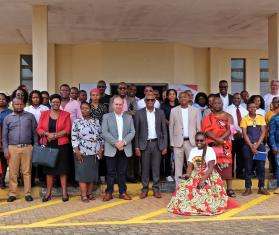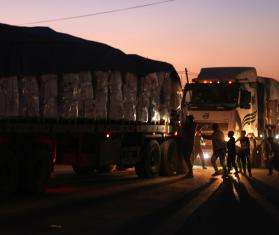Last updated on April 15, 2024
After several weeks of intense fighting with Palestinian armed groups in Khan Younis, Israeli forces stormed the facility, which until then had been under siege. The orthopedic department was hit, killing one person and injuring eight others.
Doctors Without Borders/Médecins Sans Frontières (MSF) staff members working at the hospital were firsthand witnesses. Their accounts, which have been corroborated by other sources, retrace the events leading up to the night of February 14–15 and the forced evacuation of the hospital. In November 2023, MSF documented similar attacks on Al-Shifa and Al-Quds hospitals, and on Al-Nasr Children’s Hospital in the north of Gaza.

Summary
The sources to which we have had access include firsthand accounts from MSF staff , exchanges of information between our coordination team in Jerusalem and our teams in Gaza as recorded in an MSF logbook,* and publications by media and humanitarian actors. All of these sources corroborate this story.
In early December, airstrikes and ground fighting intensified in southern Gaza, following a seven-day truce that began on November 24. Many people took refuge in and around Nasser Hospital in Khan Younis. At that time, the medical complex was receiving recurrent mass influxes of wounded; it was also treating displaced people and those who could not be treated elsewhere in Gaza, where two-thirds of hospitals had already been forced out of service. On January 21, medical staff reported that the hospital was surrounded by Israeli forces. On January 23, the Israeli army sent evacuation orders to the residents of blocks 107 to 112, which included Nasser Hospital. From that day, the hospital was at the center of intense fighting and was considered by the medical staff inside to be under siege.
No one could enter or leave the hospital without risking their lives and ambulances were denied access. On February 8, MSF staff reported sniper fire targeting Nasser Hospital, resulting in several deaths and injuries. On February 13, the Israeli army issued an evacuation order for displaced people who had taken refuge inside the facility but said that medical staff, their families, patients, and one caretaker per patient were allowed to remain inside the hospital. On the night of February 14 – 15, despite security guarantees from the Israeli army that those remaining in the medical complex would be safe, an Israeli shell hit the orthopedic ward, killing one person and wounding eight others.
Israeli forces ordered everyone inside Nasser Hospital to evacuate and then stormed the hospital early in the morning on February 15. Everyone who left the hospital was screened by Israeli forces and one MSF staff member was detained and released on April 4.
In the days following February 15, patients were evacuated in small groups to several nearby field hospitals. On February 22, the Israeli army withdrew from Nasser Hospital and left it severely damaged and unable to function.
* The MSF logbook is an internal document in which daily information is recorded relating to the management of MSF projects. It includes the medical activities of teams working in Gaza's health facilities, security incidents, patient evacuations via Rafah, and fuel supplies. It reflects the exchange of information between MSF’s coordination team in Jerusalem and MSF’s teams in Gaza.
December 1
Fighting resumes between the Israeli army and Hamas, ending a seven-day truce that began on November 24.
December 17
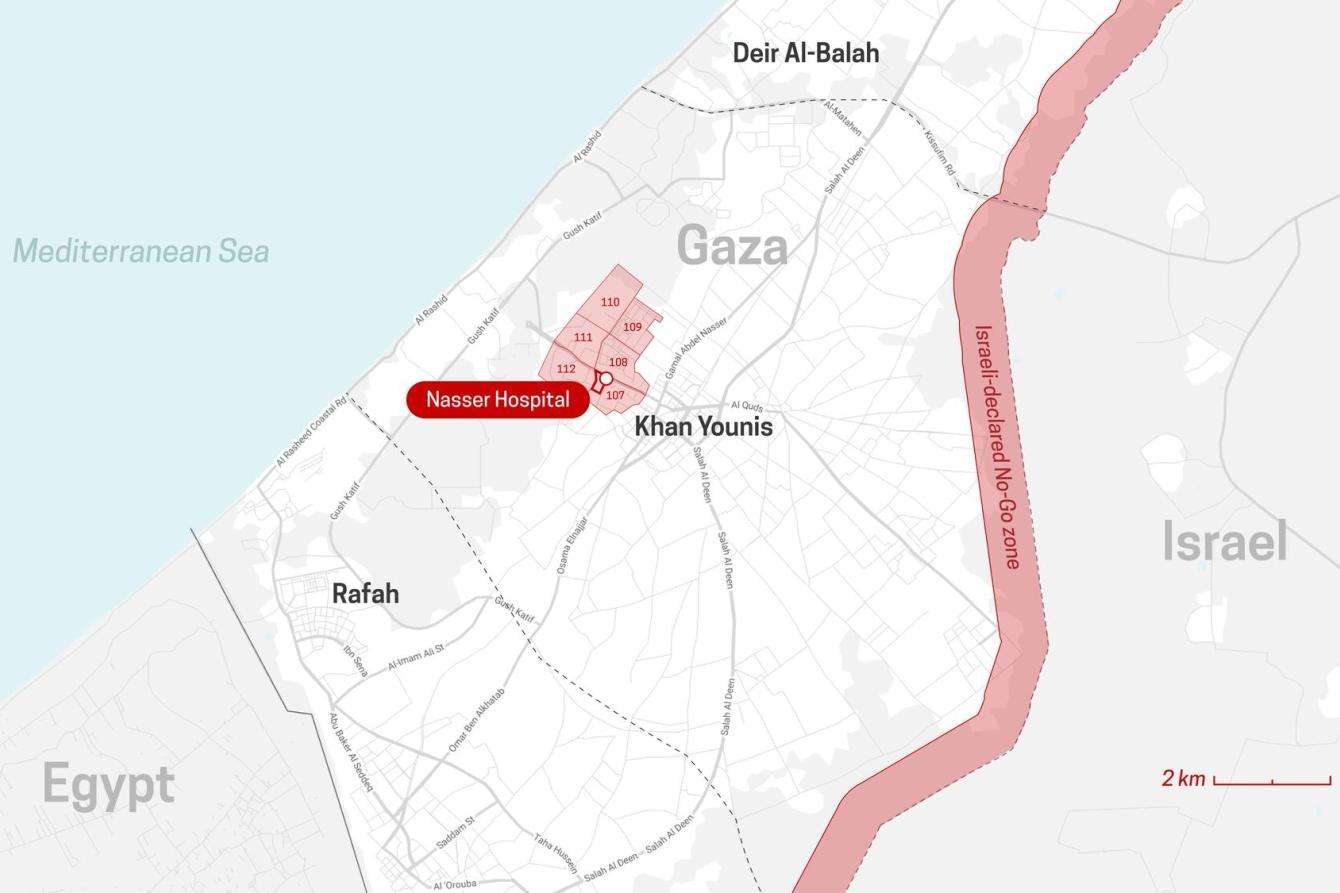
December 25
January 8
The Israeli army shells an MSF shelter housing over 100 staff members and their families in Khan Younis. The five-year-old daughter of one staff member is killed.
January 13
“We’re gradually being cornered in a very restrictive perimeter in southern Gaza, with dwindling options to offer critical medical assistance, while the needs are desperately growing. As the assault on Gaza has progressed, we have had to evacuate several health facilities in the north of Gaza, then in the Middle Area. Today we are limited to mainly working in the south because we cannot work elsewhere. In short, we’re running out of hospitals. We are forced to leave patients behind.”
January 15
“On January 15 at around 3 p.m., an airstrike hit trucks that were unloading food 150 meters [approximately 500 feet] east of the hospital. The noise was so loud that it was painful for the ears. After a few minutes, many wounded arrived at the hospital, some carried by people on foot, some by ambulances, and some in private cars. Total of eight killed, including two boys four [or] five years old, and 80 injured, including 20 who had to undergo surgery. The next morning we visited a young boy around 10 years old who was hurt by the blast when crossing the street.”
“The hospital is completely full. Every room, for example, that is supposed to be a double room contains like five beds for five patients plus their family.
In every corridor, you can find patients lying on stretchers, on mattresses. There are a lot of internally displaced people inside the hospital. In every single corner, every waiting room, or even in the courtyard, you have tents, you have people sheltering inside the hospital.
The patients in the hospital suffer—an extremely vast majority of them—from explosive injuries, a lot of orthopedic injuries, then having fractures plus the soft tissue around the fractures being extremely wounded. They underwent several surgeries.
Some are not only wounded but burned as well after the explosion.
We saw a lot of patients coming as a family with several wounded. Some of the family members unfortunately died during the attack and the ones we saw were the ones who survived—wounded but survived. So many of them, [including] kids, are physically injured of course but psychologically traumatized as well from everything they went through.”
January 18
On the same day, the Israeli army bombs a residential complex housing the emergency medical team (EMT) of the International Rescue Committee and members of Medical Aid for Palestinians and their families. Israeli forces were aware of the presence of those teams on site. Following the attack, the EMT is forced to suspend its medical activities at Nasser Hospital.
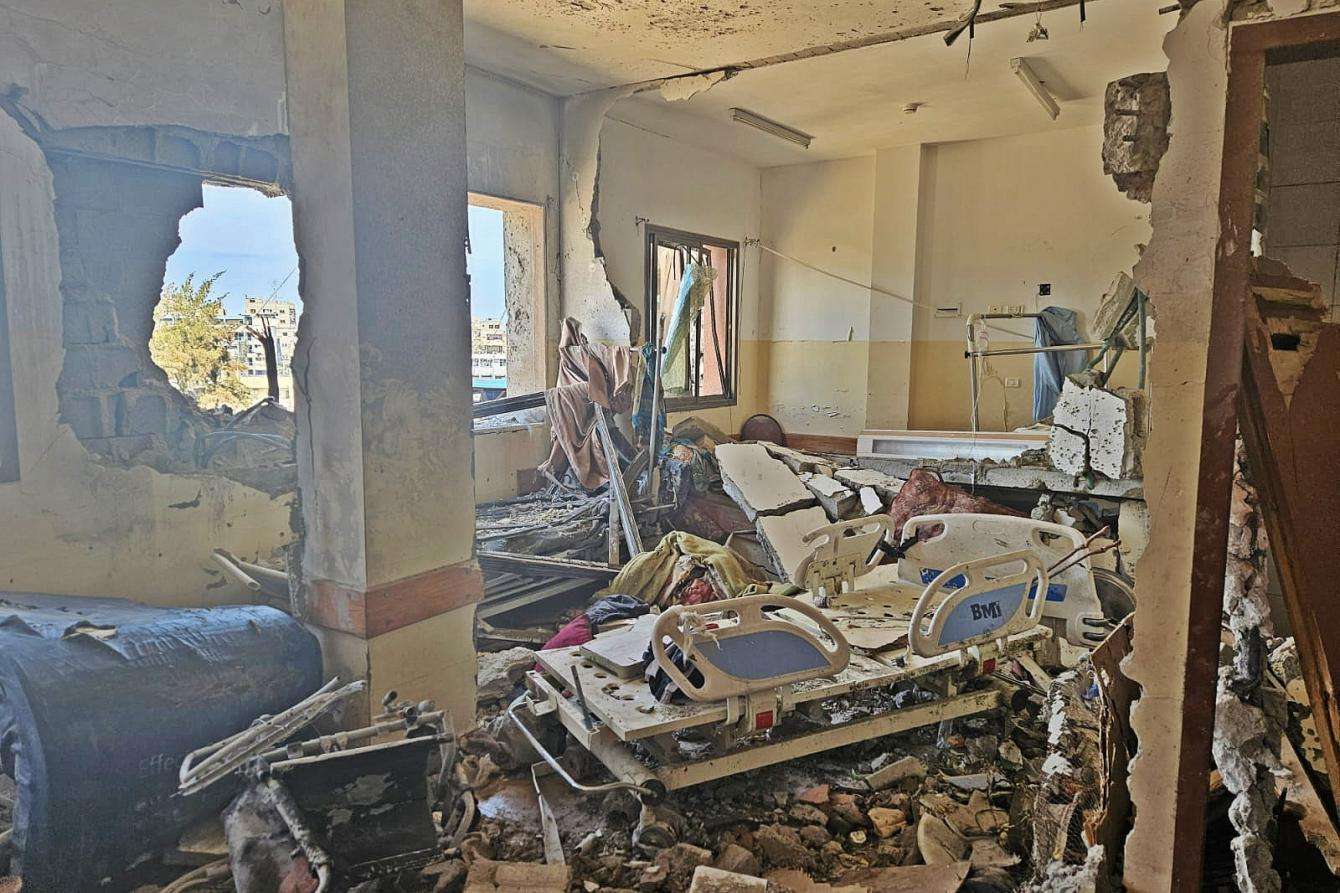
January 21
"It was very difficult as it was getting worse day by day. At first, the Israeli army was saying that the operations around the hospital and [in] the hospital [were] safe. After that, the hospital was surrounded by snipers.
Many people were injured and killed when trying to leave the hospital. The first times the Israeli army asked everyone who heard this warning to evacuate [were] on January 21 and 23, and most of those who evacuated returned back inside the hospital saying there are many being injured and killed at the street, Bahar Street. For me, it was not possible to leave the hospital after this date on January 21 because the hospital was besieged in less than four hours.”
January 23
On the same day, three MSF staff members try to evacuate the hospital, but are unable to do so. They report gunfire and explosions all around the hospital.
January 25
January 26
“The IDF [Israel Defense Forces] has been liaising with the hospital directors and medical staff, on the phone and on the ground, to ensure that the hospitals can remain operational and accessible. The IDF communicated that there is no obligation to evacuate the hospitals. On the contrary, we have reiterated the importance of safeguarding and protecting these hospitals so that they can continue providing medical services to the people of Gaza. IDF forces were briefed about the importance of operating with caution in the area of the hospitals and designated shelters prior to their operation against Hamas in this area.
Gazans who wish to move from the Nasser and Al-Amal hospitals, as many have chosen to do, can pass through the corridor on the Al-Bahar street, located on the western side of the hospitals.”

January 26
“There [were] no staff left at the emergency room [ER] of Nasser Hospital. There were no beds, just a few chairs and no staff, just a few nurses. We took the patients to the ER to provide first aid. We managed with what we had, tried to stop the bleeding and sort the patients there. It was a horrible event and really affected me psychologically ...I went to the surgical room to receive a patient in our department and asked the few remaining staff if they could supply an abdominal gauze. They said that they didn’t have any to spare and that the ones they had were already being used on several patients. They use it once, then squeeze out the blood, wash it, sterilize it, and reuse it with another patient. This is the situation in Nasser’s operating theater, can you imagine?”
January 27
Dr. Ahmed Moghrabi, a surgeon at Nasser Hospital also working for MSF, describes conditions inside the hospital to several media outlets including the New York Times.
January 29
January 30
February 6
February 8
"No one could leave the building and the hospital became full of garbage and [the person who] was killed was lying on the ground and no one could reach him. Honestly, there is no specific moment for me because all the times were terrifying and the only thing I thought about [was] getting out of the hospital. One of my team colleagues was shot in the shoulder and the chest while he was in the break room on February 8.”
February 11
February 13
An Israeli military bulldozer destroys the gate at the northern entrance of the hospital, followed by a tank. The soldiers on site order displaced people to leave the hospital. A handcuffed Palestinian prisoner wearing white personal protective equipment (PPE) is later sent into the hospital by the Israeli army to order displaced people to evacuate once again. Images available online, published by several media outlets, show that he was then executed.
"During February 13 and 14, we were informed by the hospital administration that they had been informed by the Israeli army that all people must leave the hospital except for the medical staff and their families. I left with my family on [February] 15 at 3 am, when the Israeli army gave a deadline to everyone to leave the hospital before entering it."
Night of February 14 – 15
February 15
“[At] of the time of writing of this update, on February 15, Israeli forces reportedly entered Nasser Hospital in Khan Younis, including the maternity department, according to MoH [Ministry of Health] in Gaza. The Israeli military has alleged that Hamas was holding hostages or withholding the bodies of Israelis within the compound. The World Health Organization (WHO) Director-General, Tedros Adhanom Ghebreyesus, reported that two planned missions to reach the hospital over the past four days had been denied access and his staff have lost contact with the hospital personnel.”
Dr. Ahmed Moghrabi talks to Agence France-Presse about the night of February 14 – 15 and his evacuation from Nasser Hospital.
“About the patients that stay in the hospital, about 170 patients were unable to walk and their health condition was so difficult due to the lack of food and appropriate stuff for each case. The bombing was continuous and violent and we couldn't actually determine the location of the bombing. After preparing to leave, we heard that the bombing was in the orthopedic department due to the Israeli army.”
February 16
February 17
Still active combat zone around, ambulances couldn’t enter the compound, patients carried out manually.
February 20
“The situation in Nasser Hospital is yet another example of the way health care facilities are being dismantled one by one in this war. Even though they were initially told they could stay inside the facility, medical staff and patients were put in danger in a place where they should have been protected.”
February 21
“On February 20, PRCS [Palestine Red Crescent Society] ambulances evacuated 21 injured people from Nasser Hospital, also in Khan Younis, to two field hospitals in Rafah, in collaboration with WHO and OCHA. The previous two days, the same partners had evacuated 32 patients in critical condition from Nasser Hospital to three other hospitals in Gaza following the siege and raid on the hospital complex by the Israeli military.”
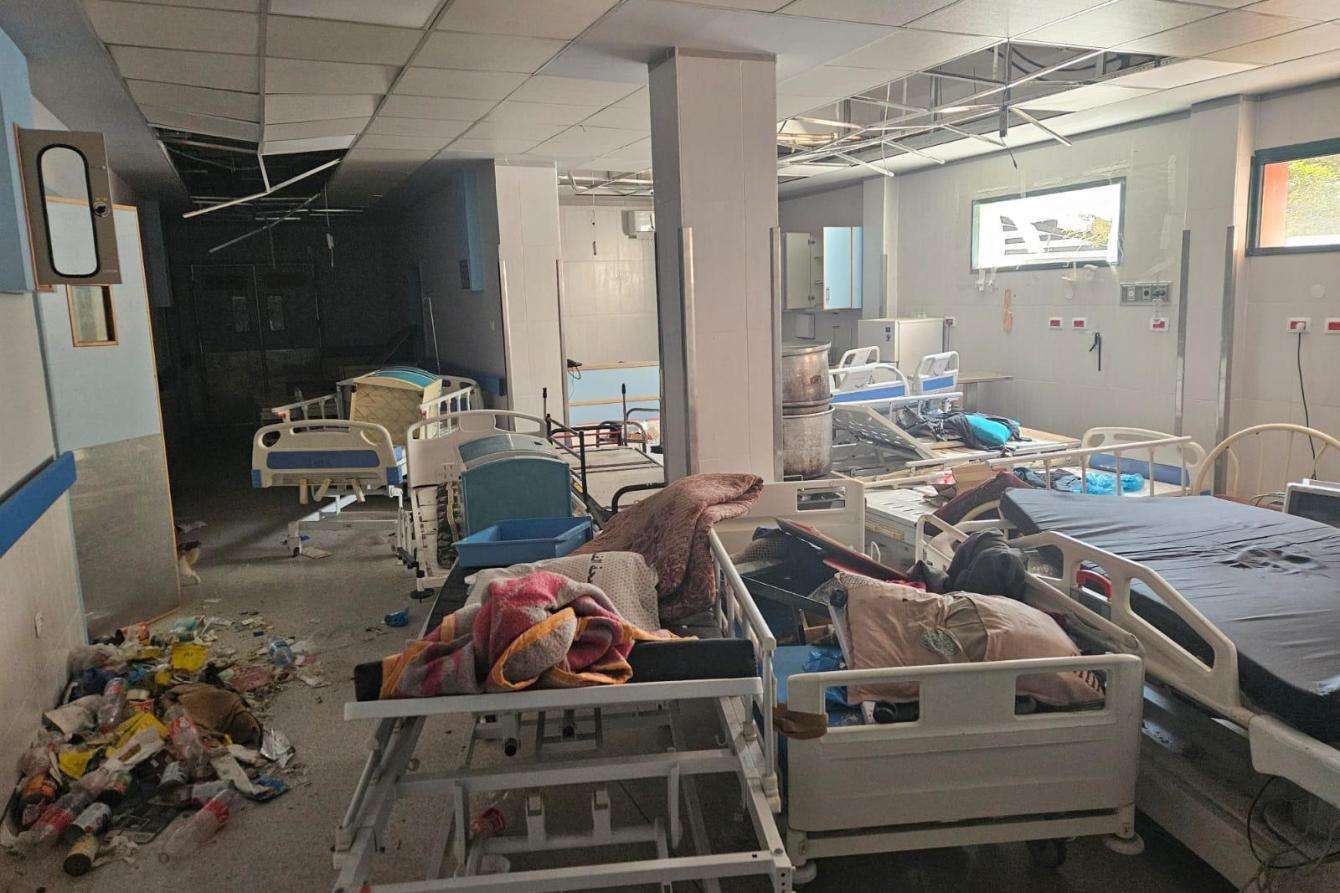
February 22
February 27
March 12
BBC releases verified footage showing detained and kneeling people inside Nasser Hospital after it was raided by the Israeli army.
March 17
March 22
"The road is not even a road anymore, it's like mountains of destroyed houses and destroyed shops everywhere. When we arrived in Nasser [it was] not functioning at all; now half of the building is sheltering some IDPs [internally displaced people], mainly former staff working over there who lost their house, so now they are sleeping inside the ward, and all the building is completely dirty, full of dust and cats—lots, thousands of cats inside. One of the walls has been damaged, but it's the only one on the fourth floor, the orthopedic wall.
One of the MSF staff, one of the drivers, was crying during the trip when he discovered the street and the building, what was remaining. One of our other staff just arrived in the hospital, and he really almost collapsed, and couldn't see and couldn't talk anymore, and he really needed time to realize what Nasser is now."
According to WHO, less than a third of Gaza's hospitals are partially functional. Between October 7, 2023, and March 12, 2024, there have been 412 attacks on health care reported by the Ministry of Health and WHO.
MSF reiterates its call for an immediate, sustained ceasefire in Gaza – the only way to bring an end to the massacre of civilians and to allow humanitarian organizations to respond to the immense needs of a terrified, starving, and exhausted population.

